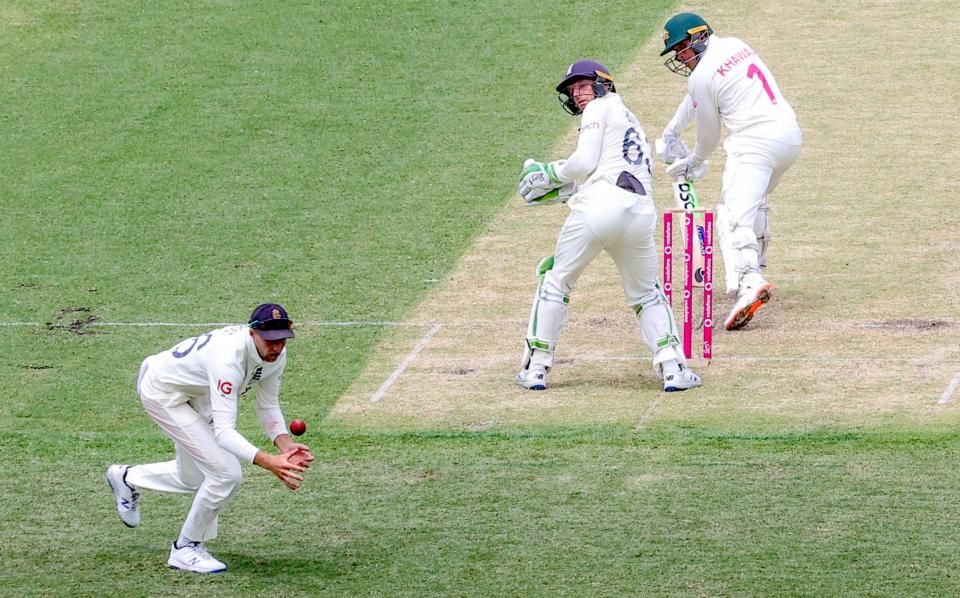Usman Khawaja's impact a sobering reminder that English cricket has got it all the wrong way around

An Ashes century in Australia? Easy as, mate. At least, watching Australia’s Usman Khawaja calmly career to one on his first Test innings in two years, in front of an appreciative Sydney crowd, made it seem so. If the standing ovation which greeted Australia’s stand-in No 4 to the crease was the loudest cheer on day one, then it was surpassed only by that which received Khawaja’s century by the afternoon of day two.
It has been quite the ride for Khawaja who, at 35 years of age and without a Test appearance since 2019, was justified in feeling that perhaps that part of his cricketing career was over. Travis Head, picked ahead of him at the start of this series, had already marked his territory with the third-fastest Ashes century in history at Adelaide. Only, in this Covid-conflicted world, nothing is certain. So, when Head duly tested positive for the virus there was no question as to who would replace him.
There has been much spoken of England’s disrupted preparation for this series, the washouts in Brisbane and the dearth of first-class cricket afforded their under-performing batters. Yet Khawaja hasn’t had a game, with any ball colour, in the last couple of months, having dutifully accompanied Australia’s Test starters around the country since November last year. Walking out into the Sydney Cricket Ground middle however, seemed the most natural thing in the world for the Queensland captain. Undercooked? Not Khawaja.
Khawaja is a servant of the Australian game. Early in his Test career he made things look so easy, too easy at times. A critique of whether he really wanted to succeed in Test cricket duly followed each dismissal. No questions as to his appetite linger anymore. The way in which he bats may make it look like the simplest of chores; he’s fluent and graceful, calm and composed. But any nonchalance once perceived has now morphed into a patience, and an awareness of his own game.

Importantly, Khawaja is obviously enjoying his cricket, and the second wind not taken for granted. As well he might, achieving in one innings something which England’s top five have failed to in 30 attempted efforts so far. In fact, Khawaja, within his 137, has scored more runs in this Ashes than Ben Stokes, Jos Buttler, Haseeb Hameed, Rory Burns, Jonny Bairstow and Ollie Pope. ‘Sobering’ is the only adjective required.
Sure, Khawaja gave a chance on 28, a sharp edge not taken first by Jos Buttler and then again on a second attempt once parried to Joe Root at first slip, but that was all the reset Khawaja required. It’s also about par for the course for this England side too, who now average more than two drops per innings, having failed to hold onto 16 possible catches so far this series.

Khawaja’s personal story might be heart-warming but what it demonstrates for Australia is a more telling one. That the host’s sixth-choice top-five batter can so comfortably reach a century, while Australia’s fast-bowling depth has reeled out consecutive five-wicket hauls for its second string attack, is in stark contrast to England’s own red-ball stocks. If we talk about Khawaja’s understanding of his own game, we should perhaps talk about his age too. England have it all the wrong way around; they rely on veteran fast bowlers to keep England’s injury-stricket attack alive, while shoving a conveyor belt of young twenty-somethings into the bright cauldron of Ashes cricket.
At 35, Khawaja now might hope for some years yet in the Test arena. After his Sydney century he will surely be on the plane for Australia’s string of away series on the sub-continent, as they travel to Pakistan, Sri Lanka and then India. And he can look to a strong legacy of recent Australian batters who have flourished well into their thirties. Chris Rogers, for example, played 24 of his 25 Tests, and scored all five of his Test centuries, beyond the age of 35. Meanwhile, England persevere with the trial and much error of their fresh young batters, the Zak Crawleys, Haseeb Hameeds, Dan Lawrences and Dom Sibleys, chewing them up, hoping (wishing, praying?) that they’re the next Joe Root before spitting them out onto the growing pile of discards.
In getting it right, and trusting the process, with patience and perseverance, Australia are nurturing a legacy of red-ball devotees. For English kids watching on, you wonder why they’d ever play red-ball cricket. The only men scoring runs in Australia are the handful who have smashed it around in the Big Bash League; on the day that England were bowled out for under 100 in Melbourne, three English batters had won the player-of-the-match award in the previous seven BBL matches.
For Australia, by contrast, while their bowlers routinely concede 10-runs per over in the white-ball tournament, aired each evening following the day’s Test cricket (both on free-to-air television), they have had the terrific sight of Australia’s seam attack terrorising England to tune into instead. Want to be a bowler? Play Test cricket. And if you want to be a batter, you’ve got David, Marnus, Steve, Travis and now Usman demonstrating the rewards that long-form cricket can bring. Take your pick, here are your heroes.

 Yahoo Sport
Yahoo Sport 





































